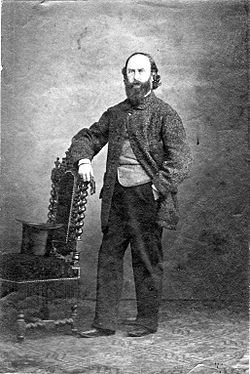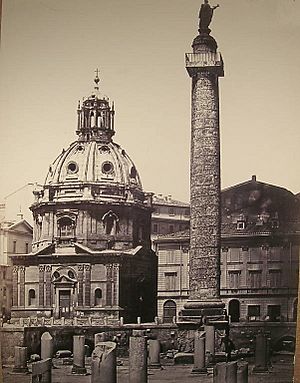Robert Turnbull Macpherson facts for kids
Quick facts for kids
Robert Turnbull Macpherson
|
|
|---|---|
 |
|
| Born | 27 February 1814 Dalkeith, Scotland
|
| Died | 17 November 1872 (aged 58) Rome, Italy
|
| Nationality | Scottish |
| Occupation | Artist, photographer |
| Spouse(s) | Louisa Gerardine Bate |
Robert Turnbull Macpherson (born February 27, 1814 – died November 17, 1872) was a talented Scottish artist. He also became a famous photographer. Robert lived and worked in Rome, Italy, during the 1800s.
Contents
Robert's Early Life
Robert Turnbull Macpherson was born in Dalkeith, Scotland. This town is just outside Edinburgh. We don't know much about his childhood.
He studied medicine at the University of Edinburgh. This was from 1831 to 1835. But he didn't finish his medical studies. Instead, he decided to study art.
Robert went to the Royal Scottish Academy in Edinburgh. He showed his portrait paintings there. This was between 1835 and 1839. One painting from this time still exists. It's called Templar Knight at Roslin Chapel. He painted it in 1836. In 1840, Robert moved to Rome, Italy.
Starting His Career in Rome
When Robert first arrived in Rome, he kept painting. He created several artworks between 1840 and 1845. Only one painting from this time is still known. It's a large oil painting of the Roman Campagna. He finished it in 1842.
Robert also worked as an art dealer. This means he bought and sold art. His most important purchase was a large, dark painting. He bought it in 1846. After cleaning it, he found out it was The Entombment of Christ. This was an unfinished work by the famous artist Michelangelo.
Robert managed to get the painting out of Rome. In 1868, he sold it to the National Gallery in London. He sold it for £2000.
In 1847, Robert met Louisa Gerardine Bate. She was 17 years old. Louisa was visiting Rome from London. Robert and Louisa fell in love. They got married in September 1849.
Robert's Photography Work
By 1851, Robert hadn't become famous as a painter. So, he started trying a new art form: photography. He used a method called the collodion process. This involved using glass negatives. By 1856, he used a different method. It was called collodio-albumin. This made it easier to carry dry plates.
Robert used large negatives for his photos. He also used long exposure times. This helped him capture amazing detail. His photos showed Roman buildings and monuments. He also photographed ruins, landscapes, and sculptures.
He carefully planned his photos. He wanted to show how buildings looked in 3D. Even though photos are flat, he made them look deep. Robert believed photography was a true art form. In 1863, he said he was still a photographer. He felt he was still an artist.
By the early 1860s, Robert was very successful. His photos were shown in Edinburgh and London. People praised his work. They said he chose his subjects well. They also said his pictures were skillful and delicate.
Robert was the first photographer allowed inside the Vatican. In 1863, he published a guide book. It was called Vatican Sculptures. The book had 125 Vatican sculptures. His wife carved illustrations for the book. She used his photographs as guides.
Even though he lived in Rome, Robert stayed active. He was a member of the Photographic Society of Scotland. A newspaper called The Scotsman wrote about him. They said he was "the father of photography in the Eternal City [Rome]."
Robert's Later Years
By the late 1860s, Robert's health was not good. He had malaria. Also, Rome became politically unstable. This meant fewer British tourists visited. Tourists were a big part of his customers. At the same time, photography changed. It became easier and cheaper. It was no longer just for artists.
Robert Macpherson passed away on November 17, 1872. His funeral was held in Rome. He was buried at Campo Verano. Sadly, his grave has been lost. He left behind his wife, Gerardine. He also had four children: William, Joseph, Ada, and Francis.
During his photography career, Robert took many pictures. He catalogued 1,019 photographs. Today, you can find many of his photos. They are in places like the George Eastman House. You can also find them at the J. Paul Getty Museum. Smaller collections are found all over the world.
Images for kids



